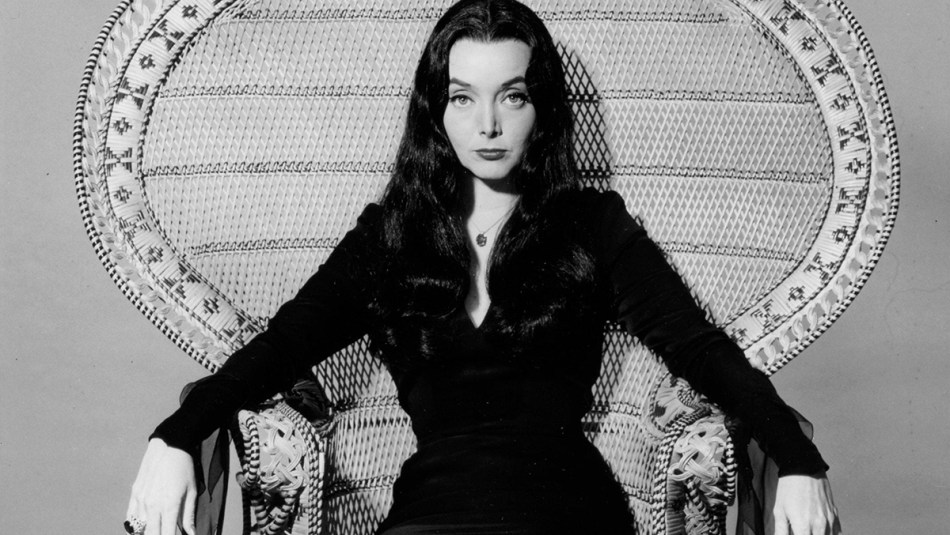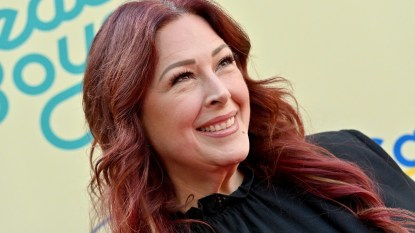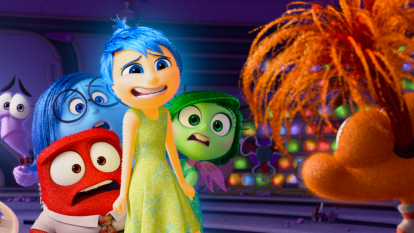Carolyn Jones: 17 Finger-Snapping Facts About Morticia from ‘The Addams Family’
Overcoming childhood illness, determination to be an actress, fighting against typecasting and so much more — it's all here!

When she signed on to portray matriarch Morticia Addams on the classic 60s sitcom The Addams Family, actress Carolyn Jones did so because she was intrigued by the part, and not, as some assume, because her film career had been slowing down. For her, the driving force of life had always been the opportunity to act, and this seemed like a good opportunity to do exactly that.
The idea of typecasting — of her coming out of the show two years after its 1964 debut with Hollywood and the public only thinking of her as Morticia — wasn’t even a consideration. In fact, she still felt that way when the show concluded its run, though it wouldn’t be long before she would come to realize that it was actually a much bigger problem than she could have ever imagined.

Carolyn Jones was born on April 28, 1930 in Amarillo, Texas. And, as you’ll see in the facts below, it wasn’t an easy childhood, marred by family conflict and a severe asthma condition that forced her early years to be restricted to home and mostly alone (except for her younger sister, Bette Rhea). Yet it was during this time that she at first became fascinated by, and then obsessed with, the idea of becoming an actress.
You can follow the journey of Carolyn Jones through the following 17 facts that chronicle much of her life and career.
MUST-READ: 1964 Classic TV Shows — 15 Series Celebrating 60 Years
1. Carolyn Jones came from a dysfunctional family

While growing up, Carolyn Jones was always considered something of a misfit. Her mother, Chloe, was agoraphobic, though the two of them were nonetheless close. Her father, Julius Jones, left the family while she was very young and she never got to meet him. As a result, mother and daughter ended up living with Chloe’s mother and stepfather, in a very small house.
2. She suffered from health issues when she was young

As a child, Carolyn suffered from lung issues, which kept her pretty isolated at home. Details pop culture historian Geoffrey Mark, “Like many young people, she looked towards show business as a fantasy for escape from her life. All she could do was listen to the radio and read movie magazines. Her life was aimed towards that, because that was her reality.”
“As a child,” Carolyn shared in an interview taking place in the early 1960s, “my health prevented me from going to school. I was not well enough to play, so I was educated with tutors. My activity was mental rather than physical.”
MUST-READ: 8 Creepy and Kooky Facts About the Original Addams Family
3. The desire to act was all consuming when she was a child

Biographer James Pylant, author of In Morticia’s Shadow: The Life & Career of Carolyn Jones, points out that acting became a true desire that burned within her. “But,” he says, “it was not relatable to people she was growing up with, so she was an outsider. Something that was true of her even as a child is that she was ambitious and driven with the goal to go to Hollywood.”
4. The Pasadena Playhouse

By the time she was 17, Carolyn had been able to convince her grandfather how important acting had become to her, and he became every supportive, paying for her to attend the Pasadena Playhouse in California.
“That’s what really changed things for her,” points out James Plyant. “She was free for the first time and in her own element. She never had employment outside of entertainment, except for a two-week period before she left Texas working for a stationery company.”
MUST-READ: Get to Know the Wednesday Cast and Everything We Know About Season 2
5. She signed with Paramount Pictures

A talent scout for Paramount Pictures caught one of Carolyn Jones’ performances at the Pasadena Playhouse, and she was signed to a contract with the studio. It seems as though she was on her way, but there were still issues that she had to deal with
6. The benefits of a nose job

It may sound unbelievable, but the career of Carolyn Jones really began to take off after she underwent a nose job, which her grandfather paid for as well. Muses Plyant, “She was not going to get the job offers without it. And everything did change following it; she was treated completely differently by Hollywood. That’s why, years later, she jumped at the chance to be in an episode of Dr. Kildare in a story about a woman who has a nose job. She related to that character so much. The story was about the aftereffect of the surgery and the character’s resentment over how men, who used to reject her, treated her differently. She had that in real life, too.”
MUST-READ: All About the Cast Members from The Munsters
7. Going blond seemed to help… a bit
In 1953, the Abilene Reporter-News featured an interview with the actress, in which she stated that to make it in Hollywood, you have to focus in equal amounts on talent and grooming. “Making my hair blond,” said Carolyn, “was an indefinite color and as soon as I became a definite blond, I was signed to a term contract at Paramount. My experience is that you get more attention as a blond, and this gives you confidence and a chain of constructive reaction begins.”
That might be true, but the results weren’t immediately apparent. As Geoffrey Mark points out, the studio system was falling apart around that time, which meant that performers were having to fend for themselves.
“She began getting small parts in good films, but there wasn’t an abundance of work. What she did, was to decide to take a risk and cut her long golden hair really short and dyed it jet black. At that point, Hollywood did notice. Producers started asking, ‘Wow, who is this girl?’ She began to be nominated for awards and did films with Frank Sinatra and Elvis Presley. Her fame began to grow. She was able to stand out.”
The Presley film was 1958’s King Creole while Sinatra’s was 1959’s A Hole in the Head.
MUST-READ: All about the supernatural sitcom Bewitched!
8. Carolyn believed in the power of being a brunette

“When I was a blond,” the actress suggested to the media in 1956, “people used to look at me and think I was sexy and feather-headed. But a brunette is a chase and conquer type girl. And as a blond, I was in competition with the Mansfields and Monroes. I spent the majority of my life trying to be an actress, not a sexpot. Now as a brunette, I feel I’ve come into my own.”
According to James Plyant, she made it clear in her diary that she actually resented all the physical changes she had to put herself through: “She felt that she was passed over for some roles because she wasn’t pretty enough. I think she looked at people not being sincere with her, because they suddenly wanted her when, previously, they had rejected her.”
9. Ageism was yet another problem

Plyant points out that by the time Carolyn Jones reached her mid-thirties, it was her feeling that the number and quality of roles were diminishing: “You know how Hollywood was at the time: 35 was considered old for an actress, and the quality roles just weren’t there. She wasn’t getting many offers, which is when television became more important in terms of her career.”
Adds Geoffrey Mark, “Her roles were always edgy bad girls, which sound ridiculous saying that these days. What I mean is women who weren’t virgins, who drank and smoked, who were bohemian, beatniks or prostitutes. Those are the kind of parts she played, and she played them well. and then about 14 years into her career, along comes The Addams Family.”
MUST-READ: 1950s TV Sitcoms: 40 Classic (and Not-So-Classic) Shows, and Where to Stream Them
10. She becomes Morticia Addams in 1964
Based on Charles Addams’ single panel comic strips in The New Yorker, the concept of The Addams Family was to take a typical American sitcom and give it a macabre twist (“I followed the directions I received on the first day of shooting, to play Morticia just like Donna Reed,” said Carolyn). Besides Carolyn as matriarch Morticia, the show, which ran from 1964 to 1966, starred John Astin as her husband, Gomez; Lisa Loring and Ken Weatherwax as their children, Wednesday and Pugsley Addams; Blossom Rock as Gomez’ mother, Grandmama; Jackie Coogan as Uncle Fester and Ted Cassidy as zombie butler Lurch.
11. Her acting skills allowed her to embody the character of Morticia
It’s Geoffrey Marks’ opinion that had Carolyn Jones not been as well-versed in her craft as she was, there would have been no way for her to bring the character of Morticia to life: “It was a very hard role to play, because she had to look as though the drawings had come to life. The same was true for everyone else on the show, but in addition, she had to have a smoldering sexuality that was not normally seen on sixties television in general, let alone sitcoms.
“The Character had to be comfortable in her own skin and warm and loving. She also needed to make Gomez look sexy, because John Astin may have been a great actor, but not known for being hysterically handsome. But because she was so turned on by Gomez, the audience knew he had to have something going on.”
Adds Plyant, “The sexuality was surprising, especially when you consider you’re coming out of I Love Lucy having twin beds and in this situations they’re being incredibly romantic, and Gomez can’t control himself around here. That simply wasn’t done on television at the time.”
MUST-READ: The 1960s — Your Guide to 60 Classic (and Not-So-Classic) TV Sitcoms and Where to Stream Them
12. Carolyn Jones enjoyed The Addams Family
An additional point Plyant makes is that The Addams Family was not a situation where Carolyn Jones was desperate for work, so she took what seemed like a bizarre role: “It was something she really could relate to. Morticia had a sense of humor and there were things woven into the character and the dialogue because of her input. One example is that Charles Addams told her about wanting to introduce the character of Cousin Itt. She responded, ‘What side of the family is he from? Both sides, I hope,’ and that went into the script.”
13. Creating the character
When she was interviewed by The Corpus Christi Caller-Times while the show was in production, she described what went into creating the character of Morticia: “A lot has come out of the costuming. My skirt is so narrow, I can only mince along like Ming Toy Goldberg. So I developed a minimum of movement, which contributes to the feeling of calmness and elegance.”
MUST-READ: 1970s TV Sitcoms — 106 Classic (and Not-So-Classic) Shows, and Where to Stream Them
14. When the show ended, she didn’t fear typecasting
The Addams Family only lasted two seasons, running from 1964 to 1966, and Carolyn didn’t seem too worried that the part would have typecasted her: “Morticia doesn’t haunt me. I have been very lucky. Producers don’t see me only as that character. I’ve been able to play a lot of different parts. I did them before The Addams Family and I’ve done them since. And I have been nominated for an Academy Award in 1957 for The Bachelor Party.”
Plyton doesn’t agree, pointing out that the more she went out for roles, the more people wanted to see Morticia. “She slowly started to realize, ‘I’m Morticia forever,’ even though she loved the role,” he says. He notes that she did enjoy guest starring on the Adam West Batman series playing Marsha, Queen of Diamonds in five episodes of the show.
She would reprise the role of Morticia in the 1977 TV movie Halloween with The Addams Family, which — because at that point she was desperate for work — she’d hoped would go to series. Unfortunately it didn’t.
15. Carolyn Jones wrote a sex novel

In 1971, she wrote a novel titled Twice Upon a Time, which was actually a sex novel — a shocking revelation at the time. Her view was there wasn’t much coming her way in terms of work, so she had to do something. “I’m not the kind of person to sit around and tend my roses,” she told The Austin American, “so I started to write a book, out of boredom. I’d also recently gone through a sexual crisis and there was a therapeutic effect in putting it down on paper.”
Plyton states that Twice Upon a Time did not go over very well with people: “It was a thinly disguised indictment of Hollywood, and because it was so sexual, it also sort of spoiled the image some people had of her. Morticia, even though she’s sexy, she’s also subtle with it and there’s no subtlety in this book. It had some success, but really didn’t do her career any favors.”
MUST-READ: My Mother the Car The 60s Sitcom That Went So Wrong
16. Her final roles
As the 1970s were winding down, Carolyn Jones began performing in dinner theatre productions — which she enjoyed, because it reminded her of her days at the Pasadena Playhouse.
Carolyn’s final role was as Myrna Clegg on the daytime soap Capitol between 1982 and 1983. “Myrna is meaner than J.R. Ewing,” she told The Kilgore News Herald in 1982. “She and J.R. are a matched set. Between them they could carve up the world. I based Myrna on three women I know and they’d kill me if I used their names.”
On the appeal of the show, she added, “Washington is the glamour and scandal capital of the world. Every single day there’s some scandal or off-beat news, where there’s more room for it. In Hollywood we have to work hard. Politicians don’t. People would be surprised to learn how many stars go to bed alone. I don’t think many senators do. They don’t have to be up at five in the morning with bags under their eyes to report to work.”
Plyton suggests, “When Capitol came along, she’d already been diagnosed with cancer. She also auditioned for other roles, including Mrs. Roper on Three’s Company, but she was turned down for that. I can imagine there she is, a talented actress with her body of work, and she has to audition at this point of her life. But Capitol came along and no soap opera had been done exactly like that before with several well-known stars attached to it. And she loved that role. She felt like she could really let loose with that character. She felt that the character was a match for J.R. Ewing.”
17. Personally speaking

Carolyn Jones was married four times: Don Donaldson (1950 to 1951), actor turned writer/producer Aaron Spelling (1953 to 1964), Broadway musician Herbert Greene (1968 to 1977) and Peter Bailey-Britton (1982 until her death).
In March of 1981, she was diagnosed with colon cancer, a fact she kept hidden from others, only telling them that she was suffering from ulcers. Although she worked on Capitol through much of her illness, in July of 1983 she slipped into a coma, dying from the disease on August 3 at the age of only 53.
“Her death was very shocking,” expresses Plyant, “and I think she was incredibly brave to keep on acting through all of that. She knew she was dying, but wanted to act as long as she could. And the fact that she took that role and did such a compelling job — while undergoing chemotherapy and keeping it quiet at the same time — is amazing.
“Her legacy,” he adds, “is her status as an icon. Her sister and I have talked about this many time. Carolyn would never have dreamt of how she would have such a following this many years after her death. A whole generation born after she died that follows her in movies and The Addams Family. She never would have imagined that possibility.”
MUST READ: Enjoy much more of our Classic TV articles!













